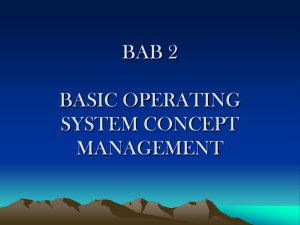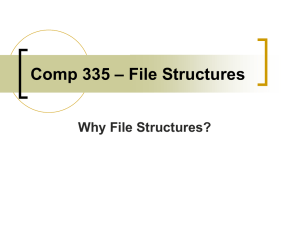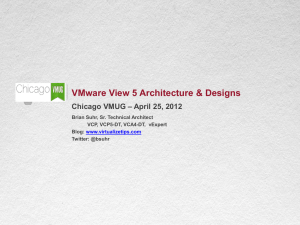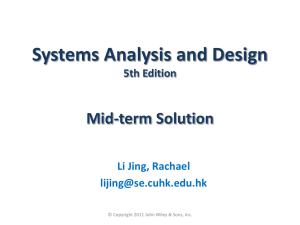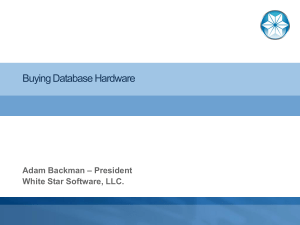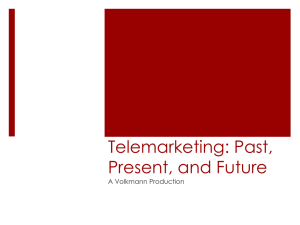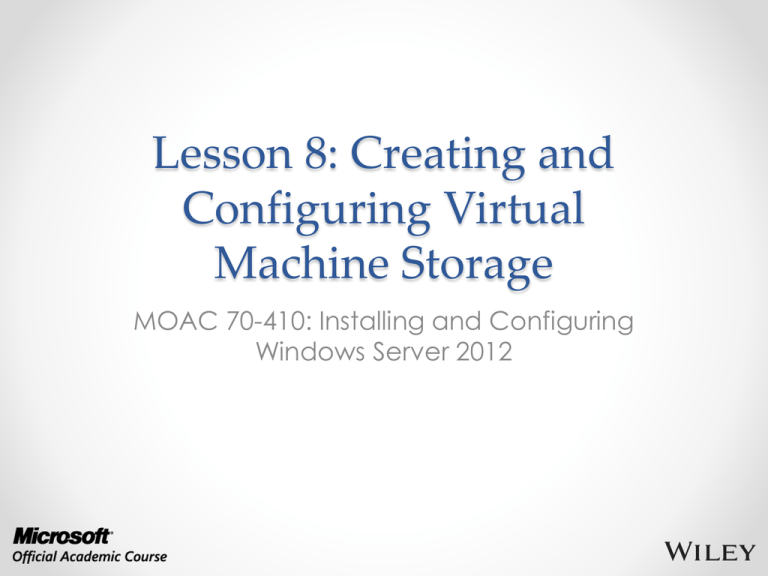
Lesson 8: Creating and
Configuring Virtual
Machine Storage
MOAC 70-410: Installing and Configuring
Windows Server 2012
Overview
• Exam Objective 3.2: Create and configure
virtual machine storage.
• Working with Virtual Disks
• Connecting to a SAN
© 2013 John Wiley & Sons, Inc.
2
Working with Virtual Disks
Lesson 8: Creating and Configuring Virtual
Machine Storage
© 2013 John Wiley & Sons, Inc.
3
Working with
Virtual Disks
• Hyper-V uses a virtual hard disk (VHD) format to
package part of the space on a physical disk to
appear to the VM as though it is a physical hard
drive.
• You can construct virtual storage subsystems to
emulate almost any physical storage solution.
• The New Virtual Machine Wizard creates the
following virtual storage subsystem:
o 2 IDE (Integrated Drive Electronics) controllers (system
drive + DVD drive)
o 1 SCSI (Small Computer Systems Interface) controller
(unpopulated)
© 2013 John Wiley & Sons, Inc.
4
Working with Virtual Disks
The default VM drive controller configuration
© 2013 John Wiley & Sons, Inc.
5
Virtual Disk Formats
Three types of VHD formats:
• Fixed hard disk image: An image file of a specified
size in which all the disk space required to create
the image is allocated during its creation.
• Dynamic hard disk image: An image file with a
specified maximum size, which starts out small and
expands as needed to accommodate the data the
system writes to it.
• Differencing hard disk image: A child image file
associated with a specific parent image. The system
writes all changes made to the data on the parent
image file to the child image, to facilitate a rollback
at a later time.
© 2013 John Wiley & Sons, Inc.
6
Virtual Hard
Disk Formats
• VHD
o Limited to 2 TB
o Compatible with all versions of Hyper-V, Virtual
Server, and Virtual PC
• VHDX
o
o
o
o
Up to 64 TB
Support 4 KB logical sector sizes
Larger block sizes (up to 256 MB)
Not backwards compatible
© 2013 John Wiley & Sons, Inc.
7
Creating Virtual Disks
• Hyper-V allows you to create virtual hard
disks as a part of a virtual machine, or
create them later and add them to a VM.
• Hyper-V Manager provides access to most
of the VHD parameters.
• Windows PowerShell provides the most
granular control.
© 2013 John Wiley & Sons, Inc.
8
Creating a Virtual Disk
with a VM
The New Virtual Machine Wizard includes a Connect Virtual
Hard Disk page, with which you can add a single disk to
your new VM with these options:
• Create a virtual hard disk: Enables you to specify the
name, location, and size of a new virtual hard disk, but
you can only create a dynamically expanding disk using
the VHDX format.
• Use an existing virtual hard disk: Enables you to specify
the location of an existing VHD or VHDX disk, which the
VM will presumably use as its system disk.
• Attach a virtual hard disk later: Prevents the wizard from
adding any virtual disks to the VM configuration. The
assumption is that you will manually add a disk later,
before you start the virtual machine.
© 2013 John Wiley & Sons, Inc.
9
Create a New Virtual Disk
The Choose Disk Format page of the New Virtual Hard
Disk Wizard
© 2013 John Wiley & Sons, Inc.
10
Create a New Virtual Disk
The Choose Disk Type page of the New Virtual Hard
Disk Wizard
© 2013 John Wiley & Sons, Inc.
11
Create a New Virtual Disk
The Name and Location page of the New Virtual Hard
Disk Wizard
© 2013 John Wiley & Sons, Inc.
12
Create a New Virtual Disk
The Configure Disk page of the New Virtual Hard
Disk Wizard
© 2013 John Wiley & Sons, Inc.
13
Create a New Virtual Disk
The Completing the New Virtual Hard Disk Wizard page
of the New Virtual Hard Disk Wizard
© 2013 John Wiley & Sons, Inc.
14
Adding Virtual Disks to
Virtual Machines
• If you chose the Attach a virtual hard disk
later option when creating your virtual
machine, you will need to attach a virtual
hard drive to one of your controllers.
• In the VM’s settings you will see 2 IDE
controllers (IDE 0 and IDE 1) and 1 SCSI
controller.
© 2013 John Wiley & Sons, Inc.
15
Add a Virtual Disk to a
Virtual Machine
The IDE Controller interface in the Settings dialog box
© 2013 John Wiley & Sons, Inc.
16
Add a Virtual Disk to a
Virtual Machine
The Hard Drive interface in the Settings dialog box
© 2013 John Wiley & Sons, Inc.
17
Creating Differencing
Disks
• Allows you to create a cloned version of a
baseline installation
• The parent disk is the baseline installation
• The child is the differencing disk
• Make changes to the child differencing disk
without changing the baseline
• You can revert back to the baseline
installation anytime
• Excellent tool for testing or labs
© 2013 John Wiley & Sons, Inc.
18
Create a Cloned Installation with a
Differencing Disk
The Configure Disk page in the New Virtual Hard Disk
Wizard, when creating a differencing disk
© 2013 John Wiley & Sons, Inc.
19
Configuring PassThrough Disks
• A pass-through disk is a type of virtual disk
that points not to an area of space on a
physical disk, but to a physical disk drive
itself, installed on the host computer.
• The VM must have exclusive access to the
physical disk.
• You must take the disk offline in the parent
operating system.
© 2013 John Wiley & Sons, Inc.
20
Configuring Pass-Through Disks
An offline disk in the Disk Management snap-in
© 2013 John Wiley & Sons, Inc.
21
Modifying Virtual
Hard Disks
• You can edit a virtual hard disk, whether you
have attached it to a VM or not.
• Use the Edit Virtual Hard Disk Wizard in the
Hyper-V Manager.
© 2013 John Wiley & Sons, Inc.
22
Edit a Virtual Hard Disk
The Locate Disk page in the Edit Virtual Hard Disk Wizard
© 2013 John Wiley & Sons, Inc.
23
Edit a Virtual Hard Disk
The Choose Action page in the Edit Virtual Hard
Disk Wizard
© 2013 John Wiley & Sons, Inc.
24
Edit a Virtual Hard Disk
The Completing the Edit Virtual Hard Disk Wizard page
in the Edit Virtual Hard Disk Wizard
© 2013 John Wiley & Sons, Inc.
25
Mount a Virtual Hard Disk
The Disk Management snap-in
© 2013 John Wiley & Sons, Inc.
26
Mount a Virtual Hard Disk
The Attach Virtual Hard Disk dialog box
© 2013 John Wiley & Sons, Inc.
27
Creating Snapshots
• A snapshot is a captured image of the state,
data, and hardware configuration of a virtual
machine at a particular moment in time.
• Offers a convenient way for administrators to
revert a virtual machine to a previous state at
will.
• Select Snapshot from the Actions pane.
• The system creates a snapshot file, with an
AVHD or AVHDX extension in the same folder as
the virtual hard disk file.
© 2013 John Wiley & Sons, Inc.
28
Creating Snapshots
A snapshot in Hyper-V Manager
© 2013 John Wiley & Sons, Inc.
29
Connecting to a SAN
Lesson 8: Creating and Configuring Virtual Machine
Storage
© 2013 John Wiley & Sons, Inc.
30
Connecting to a SAN
• A storage area network (SAN) is simply a
network dedicated to high-speed connections
between servers and storage devices.
• A SAN consists of one or more drive arrays
equipped with network interface adapters,
which you connect to your servers using
standard twisted pair or fiber optic network
cables.
• A SAN-connected server has a minimum of two
network adapters—one for the standard LAN
connection, and one for the SAN.
© 2013 John Wiley & Sons, Inc.
31
Connecting to a SAN
A server connected to a SAN
© 2013 John Wiley & Sons, Inc.
32
Advantages of SANs
• Avoid the limitations imposed by the
maximum number of devices you can
connect directly to a computer.
• Provide added flexibility in their
communications capabilities.
• Can also greatly extend the distances
between servers and storage devices.
© 2013 John Wiley & Sons, Inc.
33
Clustering in a SAN
Because any device on a SAN can communicate with any
other device on the same SAN, high-speed data transfers
can occur in the following ways:
o Server to storage: Servers access storage devices over the
SAN just as if they were connected directly to the computer.
o Server to server: Servers use the SAN to communicate directly
with each other at high speeds to avoid flooding the LAN with
traffic.
o Storage to storage: Storage devices communicate among
themselves without server intervention (e.g., performing
backups from one medium to another or to mirror drives on
different arrays).
By connecting redundant servers to the same network,
enabling them to access the same data storage devices,
you create fault tolerance—clustering.
© 2013 John Wiley & Sons, Inc.
34
Clustering in a SAN
Multiple servers connected to a SAN
© 2013 John Wiley & Sons, Inc.
35
SAN Technologies
• Hard drive arrays directly connected to a
server consist of multiple drives and a SCSI
interface.
• Some include RAID controllers, while some
are JBOD (Just a Bunch of Disks).
• Drive arrays for SANs are more complex
because they also include support for
networking and intelligent agents that
provide advanced functions, like serverless
backups.
© 2013 John Wiley & Sons, Inc.
36
Using Fibre Channel
• Fibre Channel is a high-speed serial
networking technology that was originally
designed for use with supercomputers, but
which is now associated primarily with
storage area networking.
• Supports various network media,
transmission speeds, topologies, and upperlevel protocols
• Its primary disadvantage is that it requires
specialized hardware that can be extremely
expensive.
© 2013 John Wiley & Sons, Inc.
37
Connecting Virtual
Machines to a SAN
• Windows Server 2012 Hyper-V now supports
the creation of virtual Fibre channel
adapters.
• This is essentially a pass-through device that
enables a virtual machine to access a
physical Fibre Channel adapter installed in
the computer, and through that, the
external resources connected to the SAN.
© 2013 John Wiley & Sons, Inc.
38
Connecting Virtual Machines to a
SAN
WWNNs and WWPNs in a virtual SAN
© 2013 John Wiley & Sons, Inc.
39
Connecting Virtual Machines to a
SAN
A Fibre Channel adapter in a VM
© 2013 John Wiley & Sons, Inc.
40
Lesson Summary
• Hyper-V uses a specialized virtual hard disk
(VHD) format to package part of the space on
a physical disk and make it appear to the
virtual machine as though it is physical hard disk
drive.
• A dynamic hard disk image is an image file with
a specified maximum size, which starts out small
and expands as needed to accommodate the
data the system writes to it.
• A differencing hard disk image is a child image
file associated with a specific parent image.
The system writes all changes made to the data
on the parent image file to the child image, to
facilitate a rollback at a later time.
© 2013 John Wiley & Sons, Inc.
41
Lesson Summary
• VHDX image files in Windows Server 2012 can be as large
as 64 TB, and they also support 4 KB logical sector sizes,
to provide compatibility with new 4 KB native drives.
• A pass-through disk is a type of virtual disk that points not
to an area of space on a physical disk, but to a physical
disk drive itself, installed on the host computer.
• In Hyper-V, a snapshot is a captured image of the state,
data, and hardware configuration of a virtual machine
at a particular moment in time.
• The specialized networking technologies used to build
Fibre Channel SANs have, in the past, made it difficult to
use them with virtualized servers. However, Windows
Server 2012 Hyper-V now supports the creation of virtual
Fibre channel adapters.
© 2013 John Wiley & Sons, Inc.
42
Copyright 2013 John Wiley & Sons, Inc.
All rights reserved. Reproduction or translation of this work beyond that
named in Section 117 of the 1976 United States Copyright Act without the
express written consent of the copyright owner is unlawful. Requests for
further information should be addressed to the Permissions Department, John
Wiley & Sons, Inc. The purchaser may make back-up copies for his/her own
use only and not for distribution or resale. The Publisher assumes no
responsibility for errors, omissions, or damages, caused by the use of these
programs or from the use of the information contained herein.

